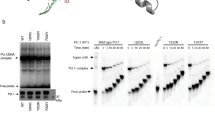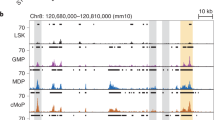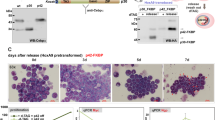Abstract
The basic-region leucine zipper (BR-LZ or bZIP) transcription factors dimerize via their LZ domains to position the adjacent BRs for DNA binding. Members of the C/EBP, AP-1 and CREB/ATF bZIP subfamilies form homodimeric or heterodimeric complexes with other members of the same subset and bind-specific DNA motifs. Here we demonstrate that C/EBPα also zippers with AP-1 proteins and that this interaction allows contact with novel DNA elements and induction of monocyte lineage commitment in myeloid progenitors. A leucine zipper swap:gel shift assay demonstrates that C/EBPα zippers with c-Jun, JunB or c-Fos, but not with c-Maf or MafB. To evaluate activities of specific homodimers or heterodimers we utilized LZs with acid (LZE) or basic (LZK) residues in their salt bridge positions. C/EBPαLZE:C/EBPαLZK preferentially binds a C/EBP site, c-JunLZE:c-FosLZK an AP-1 site and C/EBPαLZE:c-JunLZK a hybrid element identified as TTGCGTCAT by oligonucleotide selection. In murine myeloid progenitors, C/EBPα:c-Jun or C/EBPα:c-Fos LZE:LZK heterodimers induce monocyte lineage commitment with markedly increased potency compared with C/EBPα or c-Jun homodimers or c-Jun:c-Fos heterodimers, demonstrating a positive functional consequence of C/EBP:AP-1 bZIP subfamily interaction. C/EBPα:cJun binds and activates the endogenous PU.1 promoter, providing one mechanism for induction of monopoiesis by this complex.
This is a preview of subscription content, access via your institution
Access options
Subscribe to this journal
Receive 50 print issues and online access
$259.00 per year
only $5.18 per issue
Buy this article
- Purchase on Springer Link
- Instant access to full article PDF
Prices may be subject to local taxes which are calculated during checkout







Similar content being viewed by others
References
Bakiri L, Matsuom K, Wisniewska M, Wagner EF, Yaniv M . (2002). Promoter specificity and biological activity of tethered AP-1 dimers. Mol Cell Biol 22: 4952–4964.
Cao W, Britos-Bray M, Claxton DF, Kelley CA, Speck NA, Liu PP et al. (1997). CBFβ-SMMHC, expressed in M4eo AML, reduced CBF DNA-binding and inhibited the G1 to S cell cycle transition at the restriction point in myeloid and lymphoid cells. Oncogene 15: 1315–1327.
Dahl R, Walsh JC, Lancki D, Laslo P, Iyer SR, Singh H et al. (2003). Regulation of macrophage and neutrophil cell fates by the PU.1:C/EBPα ratio and granulocyte colony-stimulating factor. Nat Immunol 4: 1029–1036.
Gombart AF, Grewal J, Koeffler HP . (2007). ATF4 differentially regulates transcriptional activation of myeloid-specific genes by C/EBPɛ and C/EBPα. J Leukoc Biol 81: 1535–1547.
Hai T, Curran T . (1991). Cross-family dimerization of transcription factors Fos/Jun and ATF/CREB alters DNA binding specificity. Proc Natl Acad Sci USA 88: 3720–3724.
Heath V, Suh HC, Holman M, Renn K, Gooya JM, Parkin S et al. (2004). C/EBPα deficiency results in hyperproliferation of hematopoietic progenitor cells and disrupts macrophage development in vitro and in vivo. Blood 104: 1639–1647.
Hegde SP, Zhao J, Ashmun RA, Shapiro LH . (1999). c-Maf induces monocytic differentiation and apoptosis in bipotent myeloid progenitors. Blood 94: 1578–1589.
Hsu W, Kerppola TK, Chen PL, Curran T, Chen-Kiang S . (1994). Fos and Jun repress transcription activation by NF-IL6 through association at the basic zipper region. Mol Cell Biol 14: 268–276.
Kataoka K, Noda M, Nishizawa M . (1994). Maf nuclear oncoprotein recognizes sequences related to an AP-1 site and forms heterodimers with both Fos and Jun. Mol Cell Biol 14: 700–712.
Kelly LM, Englmeier U, Lafon I, Sieweke MH, Graf T . (2000). MafB is an inducer of monocytic differentiation. EMBO J 19: 1987–1997.
Kummalue T, Friedman AD . (2003). Cross-talk between regulators of myeloid development: C/EBPα binds and activates the promoter of the PU.1 gene. J Leuk Biol 72: 464–470.
Li A, Guidez FRB, Collier JG, Glass CK . (1998). The macrosialin promoter directs high levels of transcriptional activity in macrophages dependent on combinatorial interactions between PU.1 and c-Jun. J Biol Chem 273: 5389–5399.
Lord KA, Abdollahi A, Hoffman-Liebermann B, Liebermann DA . (1993). Proto-oncogenes of the fos/jun family of transcription factors are positive regulators of myeloid differentiation. Mol Cell Biol 13: 841–851.
Newman JR, Keating AE . (2003). Comprehensive identification of human bZIP interactions with coiled-coil arrays. Science 300: 2097–2101.
O'Shea EK, K Lumb KJ, Kim PS . (1993). Peptide ‘velcro’ design of a heterodimeric coiled coil. Curr Biol 3: 658–667.
Rangatia J, Vangala RK, Treiber N, Zhang P, Radomska H, Tenen DG et al. (2002). Downregulation of c-Jun expression by transcription factor C/EBPα is critical for granulocytic lineage commitment. Mol Cell Biol 22: 8681–8694.
Vinson CRT, Hai T, Boyd SM . (1993). Dimerization specificity of the leucine zipper-containing bZIP motif on DNA binding: prediction and rational design. Genes Dev 7: 1047–1058.
Wang D, D'Costa J, Civin CI, Friedman AD . (2006). C/EBPα directs monocytic commitment of primary myeloid progenitors. Blood 108: 1223–1229.
Wang Q, Friedman AD . (2002). C/EBPs are required for granulopoiesis independent of their induction of the granulocyte-colony stimulating factor receptor. Blood 99: 2776–2785.
Yeamans C, Wang D, Paz-Priel I, Torbett BE, Tenen DG, Friedman AD . (2007). C/EBPα binds and activates the PU.1 distal enhancer to induce monocyte lineage commitment. Blood 110: 3136–3142.
Zhang DE, Zhang P, Wang ND, Hetherington CJ, Darlington GJ, Tenen DG . (1997). Absence of G-CSF signaling and neutrophil development in CCAAT enhancer binding protein α-deficient mice. Proc Natl Acad Sci USA 94: 569–574.
Zhang P, Iwasaki-Arai J, Iwasaki H, Fenyus ML, Dayaram T, Owens BM et al. (2004). Enhancement of hematopoietic stem cell repopulating capacity and self-renewal in the absence of the transcription factor C/EBPα. Immunity 21: 853–863.
Acknowledgements
We thank K Kataoka for the MafB and c-Maf cDNAs. This work was supported by a grant from the Lauri Strauss Leukemia Foundation to DHC, a grant from the Children's Cancer Foundation to ADF and by grant R01 HL082948 from the NIH to ADF.
Author information
Authors and Affiliations
Corresponding author
Additional information
Supplementary Information accompanies the paper on the Oncogene website (http://www.nature.com/onc).
Supplementary information
Rights and permissions
About this article
Cite this article
Cai, D., Wang, D., Keefer, J. et al. C/EBPα:AP-1 leucine zipper heterodimers bind novel DNA elements, activate the PU.1 promoter and direct monocyte lineage commitment more potently than C/EBPα homodimers or AP-1. Oncogene 27, 2772–2779 (2008). https://doi.org/10.1038/sj.onc.1210940
Received:
Revised:
Accepted:
Published:
Issue Date:
DOI: https://doi.org/10.1038/sj.onc.1210940
Keywords
This article is cited by
-
Identification and interrogation of the gene regulatory network of CEBPA-double mutant acute myeloid leukemia
Leukemia (2023)
-
Targeting JNK pathway promotes human hematopoietic stem cell expansion
Cell Discovery (2019)
-
Gfi1-Mediated Repression of c-Fos, Egr-1 and Egr-2, and Inhibition of ERK1/2 Signaling Contribute to the Role of Gfi1 in Granulopoiesis
Scientific Reports (2019)
-
LPS independent activation of the pro-inflammatory receptor Trem1 by C/EBPε in granulocytes
Scientific Reports (2017)
-
The multifaceted functions of C/EBPα in normal and malignant haematopoiesis
Leukemia (2016)



